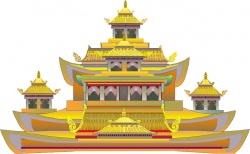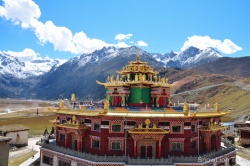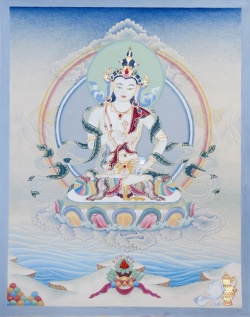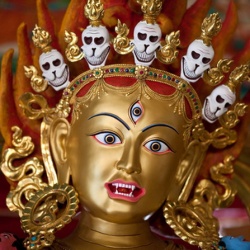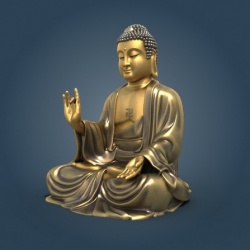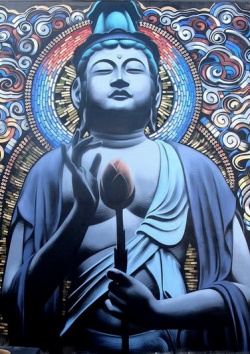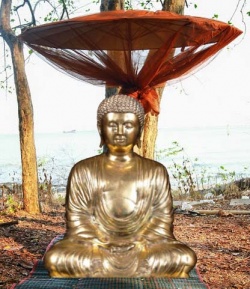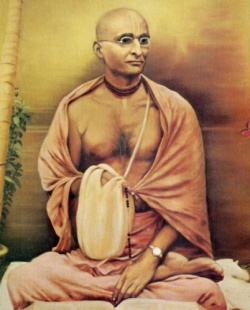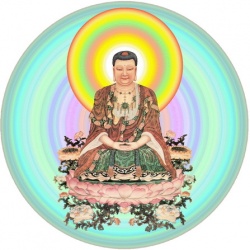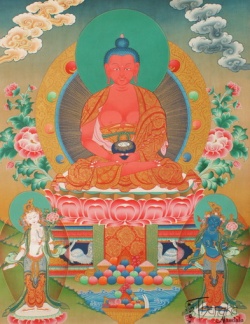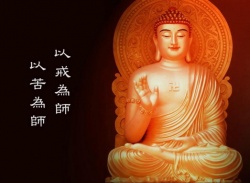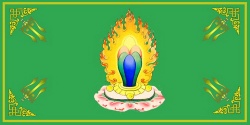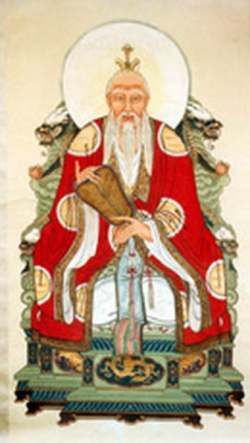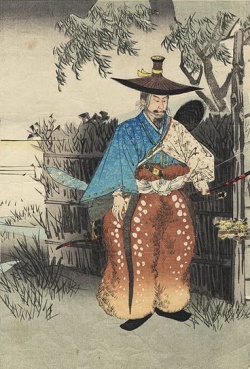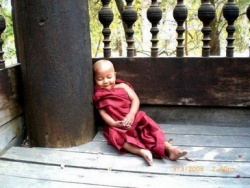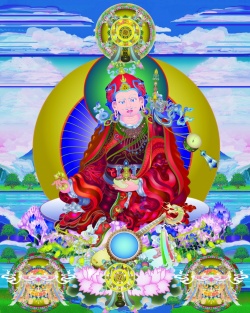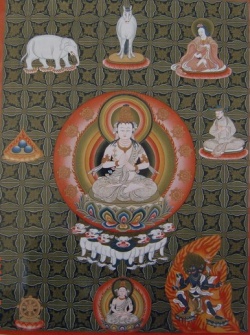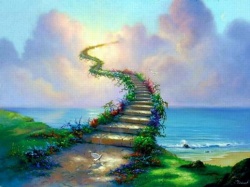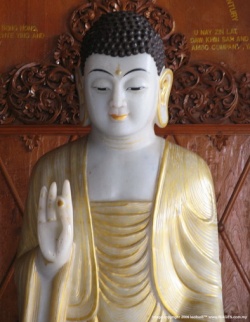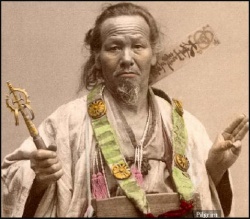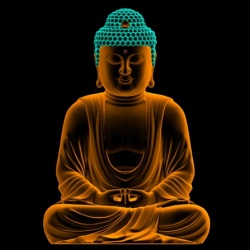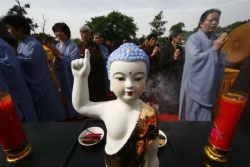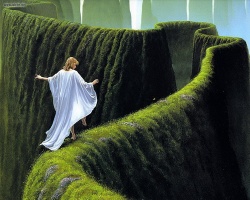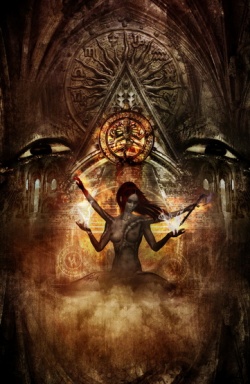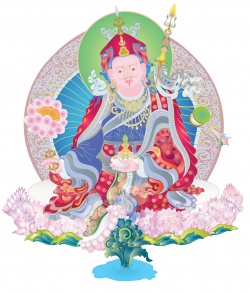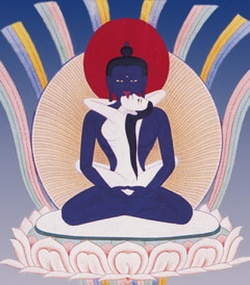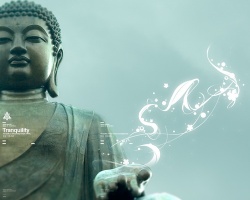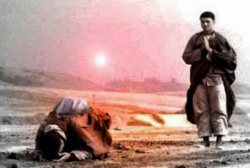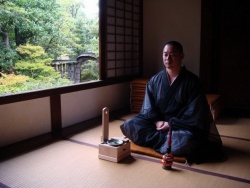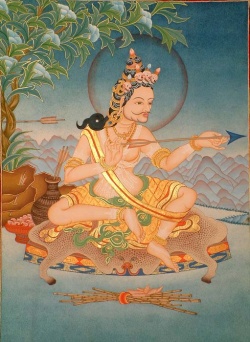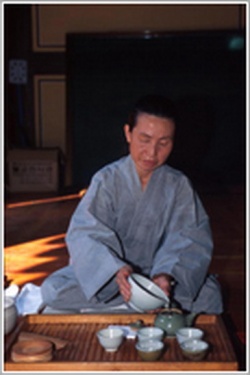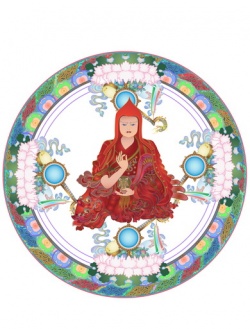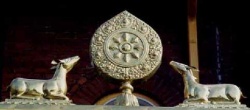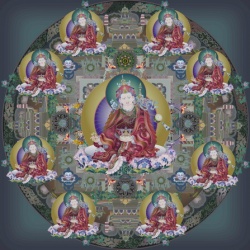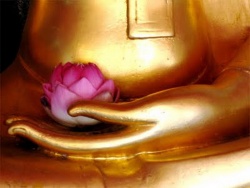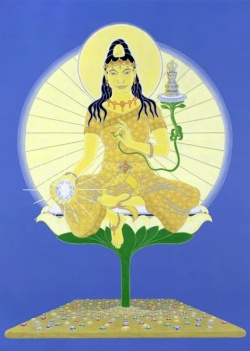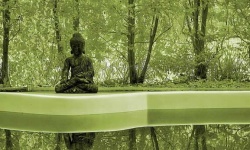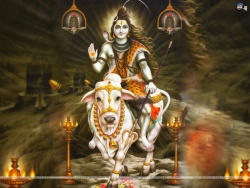The Buddha Speaks of Amitabha Buddha Sutra Part 2
Clarify the doctrine
The Pure Land Dharma Door is the faster practice track, replete with all three studies and six paramitas. The principles covered are the three requisites of the Pure Land Dharma Door:
1. Faith.
2. Vows.
3. Practice: holding the Buddha’s name.
Faith:
Faith comes first because it is the mother of all merit and virtue. Without it, one will not enter this Dharma Door and make the vow to be reborn in Amitabha Buddha’s Pure Land. Faith has several aspects. First, we should have faith in ourselves. We deserve to be reborn there. Even though we are not enlightened yet, we can carry our karma along to the Western Bliss Pure Land. Once
we are there, these past karmas cannot cause trouble and we can safely cultivate. It is unlike our Saha world where we are constantly faced with all sorts of obstructions and distractions. Once we resolve to cultivate, it is not uncommon to encounter numerous obstructions. For instance, one might get a promotion that requires one to work longer hours so that one no longer has time to visit the temple on the weekends. At a deeper level, we believe that we are endowed with the true mind, not the one with which we do mental processing, perform recognition and perceive! This true mind transcends time and space. All the worlds are simply manifestations of this true mind, including the Western Bliss Pure Land. The Land of Utmost Bliss was purified by the mind of Bhikshu Dharma Treasury while he was on his causal grounds, cultivating the Bodhisattva path.
Next, we should have faith in others, in addition to having having faith in ourselves. The true mind is present in everyone. However, we are still confused—that is why we do not know how to use it yet. Therefore, we should believe in the Buddha’s true mind. Living beings and the Buddhas all share the same nature. We are of the same substance. To believe in the Buddha is to believe in oneself.
We should trust that Shakyamuni and all the other Buddhas are speaking the truth when they praise the Pure Land Dharma Door. They really are trying to help us quickly obtain liberation.
Next, believe in cause and effect. We must have already planted good roots in the past, in order to be encountering the Pure Land Dharma Door now. We should firmly believe that reciting the Buddha’s name is the cause for rebirth. We ought to believe that rebirth of the multitude of sages in the Western Pure Land is powered by their recitation causes. We only have to follow them to make it to security. The Pure Land is no different from the pure mind. Since our mind is impure due to evil external influences, we can simply go to the Pure Land to have a better chance to purify our mind since it is free of external evil conditions. Rebirth to the Pure Land is the effect or fruition. We should deeply believe in the Western Bliss Pure land. We can truly obtain rebirth there as a result of the Buddha recitation samadhi (cause). As the patriarchs proclaimed: if we recite the Buddhas name, we will surely obtain rebirth to the Pure Land.
Next, believe in the noumena , or principles. We should believe that in principle, it is easier to obtain rebirth to the Pure Land through reliance on Amitabha Buddha’s vow powers than it is to attain enlightenment this lifetime. In fact, the Western Bliss Pure Land came about through the manifestation of Amitabha Buddha’s true mind.
We also should believe in the phenomena , or manifestations. The Western Bliss Pure Land really exists just as all the Buddhas and Bodhisattvas say. Amitabha Buddha has great affinity with the living beings of our Saha world. He created his Pure Land Dharma Door in order to make it easier for us to get out of the revolving wheel.
The Avatamsaka Sutra speaks of four Dharma Realms:
1. The Dharma Realm of Unobstructed Phenomena .
2. The Dharma Realm of Unobstructed Noumena .
3. The Dharma Realm of Noumena and Phenomena Un-obstructed .
4. The Dharma Realm of All Phenomena Unobstructed : in principle we can all become Buddhas and eventually we will phenomenally get there. It is like having a thousand torches in a room, each emits light and one does not obstruct the others. Vows:
Once we have faith, we should next make vows because we
detest the suffering of the Saha world which was created by the defilements of our mind. Whether you are rich or poor, suffering or unaware of suffering, you must wake up because life is but a dream! And then seek the peace and bliss of the Western Bliss Pure Land, a land created and adorned by the purification of our mind. All living beings in the past, present and future rely on the four great vows to realize Buddhahood: 1. I vow to save limitless living beings, according to the Truth of Suffering. 2. I vow to cut off the inexhaustible afflictions, according to the Truth of Origination. 3. I vow to study the immeasurable Dharma Doors, ac-cording to the Truth of the Way.
4. I vow to realize the supreme Buddha Way, according to the Truth of Extinction.
The process of making vows is important because it helps us reaffirm our path to Buddhahood, putting into motion an alignment of our spiritual and material resources. Seeds are formed which are then stored in our Alaya consciousness and serve as fuel to propel us towards rebirth to the Pure Lands. In particular, these seeds create handles for the Buddhas and Bodhisattvas to come along and pull us to the Pure Lands. Why did you fail in your cultivation and why do still revolve in the reincarnation wheel It is because your vows were not vast enough or not sincere enough. Now that you wish to make vows for rebirth to the Pure Lands, consider the following aspects:
1. Make vows to get out of the revolving wheel permanently. Cycling through it is rather undesirable be-cause we have very little control over where we will go next every time we change bodies. If the good seeds mature we go to the good paths of the human and heavenly realms. However, if the bad seeds are activated, we could end up in the evil paths of the asura, animal, hungry ghost and hell realms. If you understand the Dharma, you would work towards get-ting out as soon as possible. We should not seek to en-joy worldly blessings this lifetime or in future life-times.
2. Make vows to horizontally escape the Triple Realm of the Desire Realm, the Form Realm and the Formless Realm. Do not seek to enjoy the heavenly or earthly veneration and do not seek retributions with outflows.
3. Vow to universally save all living beings. Do not scheme for one life’s bliss and benefit, or to benefit only oneself.
4. Vow to be reborn to the Pure Land as soon as possible. Do not be greedy for the five desires and joys of this turbid world because they only make us stagnate and fail. Besides, they will deteriorate anyway.
5. Vow to realize one’s potential. Originally we were endowed with the full efficacious nature. Because we became confused we allowed the dusts and afflictions to obstruct and bind us. Now that we have obtained a human body, encountered the Buddhadharma, and heard of Amitabha Buddha’s Dharma Door, we should be glad, resolve to draw near Amitabha Buddha, listen to the Dharma and enlighten to the Way.
Do not keep on missing this boat. As the saying goes, “The Buddha is inside the mind and yet people go seeking outside. They are confused about the true, go chasing after the false and thus miss the opportunity for one thousand autumns ” If you can contemplate like this, then you can make an utmost sincere vow on behalf of yourself to seek a place where you can live peacefully and safely. 6. Vow to end suffering and attain bliss. Suffering and bliss are direct opposites. In the Saha world, we are oppressed by a multitude of different types of suffer-ing; in contrast, there is only bliss in the land of Ut-most Bliss.
In our world, the heavenly blessings are not permanent. The bliss in the Desire Heavens and first three Dhyana Heavens will eventually come to an end: that is the suffering of decay. When you are in samadhi of the Fourth Dhyanas of the Form Realm as well as in the Four Samadhis of the Formless Realm, you are free from suffering and bliss but cannot stop the activity skandha. Regardless, when your heavenly blessings are exhausted, you will fall. As Dharma Master ongJia says in his “Song of Enlightenment”: practicing giving and observing precepts will produce heavenly blessings. However, it is like shooting an ar-row into the sky; when the force withers the arrow will fall, bringing undesirable consequences in future lives.
There was a Taoist named Lu Chun ang who paid a visit to Chan Master ellow Dragon . Lu first hid under the bell tower to listen to the master’s sutra lecture. Master ellow Dragon knew and declared that there was a Dharma thief. Lu heard and immediately appeared to say, “I already have the immortality dharma. Why do I need to steal your Dharma” The Chan master simply replied, “ ou are a corpse guardian ghost .” Lu was unimpressed and asked, “One grain contains the entire world, a half liter pot can cook the three thousand worlds : what is that state” The Chan master replied, “Even if you can live for 80,000 kalpas, it’s just like dying in empty space .” Lu had an immediate awakening. He abandoned Taoism and became a Buddhist. The immortals failed to understand that long life or life in the heavens is not the same as being free from suffering.
Only the Pure Land Dharma Door can affect an instantaneous escape and end birth and death. 7. Vow not to regress. The Western Bliss Pure Land resi-dents are all avaivartikas: they have attained the state of “non-regressing.” On the other hand, in this Saha world, living beings commit heavy offenses and therefore encounter severe obstructions. Cultivating here is like rowing a boat upstream: it is hard to make headway and easy to fall back. This is because there is no solid, strong vow to sustain faith and practice. Therefore out of one million people, it is hard for even one individual to succeed in cultivation.
Either they quit early because they lack determination or they eventually quit because they encounter demonic obstructions, or evil friends. Typically, they have made no significant accomplishments and their lives have already come to an end. Once they are born into a new body, they forget everything and must start over again. It is not easy to succeed in the turbid world unless you have deep roots and have proper knowledge and views. Even in this case, if the conditions are unfavorable, the prior cultivation may be abandoned; if the conditions are favorable, we forget about culvitating and tend to chase after material things. Even the Tenth Faith Bodhisattvas, who already brought forth the great resolve to cultivate, will sometimes progress and sometimes regress. Like a feather floating in space, Bodhisattvas who cultivate the Ten Faiths must pass through 10,000 kalpas for the mind of faith to be complete, the good roots to mature and certify to the First Dwelling, thus obtaining non-regression in position . If you recite the Buddha’s name and obtain rebirth to the Western Bliss Pure Land, you can immediately certify to the three non-regressions of position, practice and mind. 8. Vow to be born by transformation on a lotus flower and personally see Amitabha Buddha. Then this life will not have been in vain.
The Dharma Flower Sutra says, “For a Buddha to appear in the world is rare like the uppala flower.” We are born in the Dharma ending age after the Buddha entered Nirvana. et we are blessed enough to obtain this human body and have the opportunity to practice the Pure Land Dharma. There-fore, we should seize the opportunity and make the re-solve for Bodhi, vow to be born on a golden lotus dais and personally see Amitabha Buddha. During the Song dynasty there was a bhikshu named Mind Jade who vigorously cultivated the pure conduct on Mount Tian Tai for a length of time. One day he saw Amitabha Buddha appear in space with heavenly music resounding. Amitabha was holding a silver lotus dais to bring him back to the Pure Land. The master immediately realized that his lifetime of devotion to reciting the Buddha’s name earned him this honor. However, it was not what he expected and therefore he refused to go with Amitabha Buddha. He knew that his practice was not good enough and therefore applied himself even more diligently. Three weeks later, he saw Amitabha in his golden body holding a golden dais coming for him saying, “ our vow is now accomplished.”
The master thus put his palms together, sat in full lotus and was reborn. Heavenly music could be heard in space even though there was no one playing. People listened with great delight. One of the master’s disciples was an official. He was so moved by the experience that he composed a poem to commemorate the occasion. This is a true story that was recorded in the historical records. Question: ou advocate using the rebirth plaque Dharma to start accruing rebirth blessings now, and not wait until after death as is the current prevailing custom. However, if we have a lot of rebirth blessings, would that not shorten our life Answer: As the above anecdote about Dharma Master Mind Jade illustrates, having a lot of rebirth blessings will not necessarily shorten your life as some might fear.
No one will force you to go before you are ready. And yes, I do think that for people who are blessed, they should take advantage of the unique Mahayana rebirth plaque Dharma in order to accumulate rebirth blessings because: 1. It would help make a better case for rebirth should they who have to meet with the judge, King ama, at that time when they need to change bodies. 2. The more blessings one has, the higher one’s rebirth grade will be. 3. This Dharma can help resolve the many obstructions for attaining rebirth to the Pure Land. We have a student who is in his fifties who has been sincerely and faithfully making offerings to Orthodox Mahayana temples for over twenty years. He found out that he had colon cancer and must go under the knife. That is very bad news because it is a major surgery. Because his Orthodox Mahayana temples did not allow for rebirth plaques until after death, he came and requested a rebirth plaque from us saying,
“I know that you advised us to get the rebirth plaque and I’ve always thought that I had time. Please help me accrue rebirth blessings just in case I don’t make it through surgery.” When he went under the knife a few weeks later, he survived surgery. However, he had to go to the intensive care unit and almost died. When he came back he recounted that, on the verge of death, his mind was totally chaotic. He saw a lot of frightening things. He also saw his Chinese Master and our temple Dharma protector watching over him in the background. ou do not have to die before you are ready to use this Dharma. Practice: Holding the Buddha’s name.
Inadequate vow power will not lead to practice. Practice is like tossing the water-clearing pearl into the mud so that the muddy water becomes clear. When the Buddha’s name enters a confused mind, the confused mind becomes a Buddha mind . Practice can increase sincerity. There are four methods of reciting the Buddha’s name:
1. Contemplating and thinking recitation ( ; from The Contemplation Sutra, also known as the 16 Contemplations Sutra): One popular practice is to con-template the reward body as described in the Amitabha praise. The Contemplation Sutra lists sixteen successive contemplations.
2. Contemplating a Buddha image recitation ( ; from the ban zhou san mèi jing ): Select a statue of the Buddha that you like. Recite the Buddha’s name while contemplating it.
3. Holding the name ( ; suitable for a wider range of roots): This is by far the most widely prac-ticed method. Keep reciting the Buddha’s name to pu-rify your mind and you can enter samadhi.
4. Real Mark Buddha recitation ( ): When late Master Xuan Hua explained this, he said it is doing the hua tou such as, “Who is reciting the Buddha’s name” It confused me for quite a while. Later I understood differently. Real Mark recitation is what en-lightened beings do when they recite the Buddha’s name. However, the Pure Land practice is not confined to the above methods. There also are:
5. Bowing ( ; the first of Universal Worthy Bodhisattva’s ten limitless practices).
6. Making offerings ( ; the second and third of Uni-versal Worthy’s ten practices).
7. Repentance (; Universal Worthy’s unlimited practices number 4, 5, 6, 7, 8, 9, 10).
This is described in chapter 40 of The Avatamsaka Sutra. Ultimately, we practice reciting the Buddha’s name in order to attain the “one mind unconfused” state; in other words, to obtain the Buddha recitation samadhi. If we can do this, then we will be assured of rebirth at the end of this lifetime. Practice is of critical importance if you wish to be reborn. Practice requires really putting in effort which can only follow deep faith and sincere vows. These are the three requisites for the Pure land Dharma Door. They are like a three-legged bronze censor: missing any leg would not do. Practice can have two aspects:
1. Phenomenon practice .
2. Noumenon practice .
The phenomenon practice belongs to phenomenon marks. We use the mind, as the subject , that can recite the Buddha’s name, which is the object . Subject and object are clear and distinct . When the mind and Buddha, subject and object, are in accord , then the mind is not apart from Buddha , and Buddha is not apart from the mind. One is clearly aware of the recitation , which is uninterrupted. Whether walking, standing, sitting or reclining, we are not apart from the Buddha’s name. The concentrated mind dispels the false like the frozen lake stops the water flow . Then the Buddha is like the Autumn moon shining in space—clear, brilliant and unmoving .
We can thus enter samadhi. This state is described in the Han Shan poem :
My mind is like the autumn moon ,
Or a green pool that is pure and clear .
Nothing can compare .
How can I express it !
This state of recitation of the Buddha’s name with one mind unconfused is like how one arm connects to the other arm through the chest. One holds the name in the mind without forgetting, to the point where no other thought arises. The Buddha’s name follows in thought after thought with no other thought and without interruption , . That is true vigor! Notes to the advanced practitioners: Noumenon practice belongs to the principle nature . The mind that recites the Buddha’s name neither dwells in existence nor falls into emptiness. It dwells and yet does not dwell : it dwells in the Middle Way of the principle nature . One awakens to and knows that outside the mind that can recite (subject), there is no Buddha that can be recited (object) , . Conversely outside the Buddha being recited , there is no mind that can recite . Both subject and object are extinguished . Mind and Buddha are one Suchness . Mind is just Buddha , Buddha is just mind. There are no two marks, often described as non-dual , and one understands that there is nothing to attach to . The ancients say: Suddenly the thought of Amitabha arises ; The ground is leveled, there is no wind, the wave arises by itself ;
Thought after thought dissipates and returns to non-thought thoughts ;
Even knowing of non-thought is excessive !
When you reach this state, there is a block of empty spiritual essence and the principle nature reveals itself . The Three Essentials of Pure Land , a collection of Dharma talks by Luò Jì Hé , classifies reciting the Buddha’s name into: 1. Proper practice and
2. Aiding practice . There are eight kinds of Proper practice:
1. Gathering in the mind recitation : This means to recite everywhere without forgetting, with no other thoughts; even in sleep one does not stop reciting. 2. Valiant recitation : It is like being willing to give up one’s life for an ideal, nothing can stop us.
3. Deep mind recitation : Even though the ocean is quite deep, one must get to the bottom; the road to enlightenment seems so distant but one must get to the end without resting.
4. Contemplating and thinking recitation : In thought after thought, contemplate the 32 hallmarks and 80 subsidiary characteristics.
5. Extinguishing the mind recitation : Recite the Buddha’s name and extinguish the mind that seeks fame and profit, schemes for an official position, in-dulges in desires, engages in worldly pursuits, is greedy for love, is arrogant, likes to cover up, and discerns self and others, right and wrong. 6. Compassionate crying recitation : Each time I think of the Buddha, my body hair stands on its end , the five organs ( heart, liver, spleen, lung, and kidney) are torn . I remember how often I failed to carry my parents (meaning being filial) , and now this wiser son really misses them . Make a vow to quickly succeed in your practice so that you
can help those you loved, who already have passed on before you could help them.
7. Angry recitation : To bring forth great determination arising from anger or disappointment. It is just like failing the Imperial Examination for the civil service in Ancient China, and feeling left out in the cold . Because my talents are not recognized, I feel lonely and dejected . My thoughts are oppressive and I become disenchant-ed with life . 8. Universal recitation : Seeing, hearing, awakening and knowing , within the hair pores, bones and marrow , nowhere is not reciting Buddha’s name . Reciting like this , deserves to be called pure recitation . As for aiding practices, there are six kinds:
1. Pure virtues : Besides reciting the Buddha’s name, we should also do good and plant blessings which we dedicate to the Western Pure Land.
2. Pure precepts : All the pure Dharmas rely on the pure precepts. Before entering Nirvana, the Buddha reminded his disciples to take the precepts as their teacher. The Contemplation Sutra states that among the cultivation of the three blessings, purely observing precepts and maintaining awesome comportment rank at the top.
3. Pure repentance : The sutra says “the previous mind that commits offenses is like clouds covering the sky; the ensuing mind that eradicates the offenses is like the torch that dispels the darkness.” There is inner repentance , outer repentance , phenomenon repentance , noumenon repentance etc…
4. Pure contemplation : Besides reciting the Buddha’s name, one should use the Contemplation Dharmas to burnish the mind, purifying it. There is contemplation of the impure , curative contemplation , shame and remorse contemplation , kindness and compassion contemplation and others.
5. Pure place : We recite the Buddha’s name in order to escape the dusts. Therefore we should detest evil places and seek good places that are suitable for practice. We should distance ourselves from noisy, crowded, tumultuous places, avoid entertainment and drinking places, and sever the bonds of favors and love.
6. Pure companion : True potential cannot be realized without companions; evil dharmas cannot be stopped without a friend. It is like a two-wheeled cart: lacking one wheel will render it useless. Draw near companions who treasure pure places like in the mountains, who strictly observe precepts, whose wisdom is deep and vast, who are humble, modest, patient etc… Distance from evil companions lest the mind for the Way will be harmed or lost.
One who practices the recitation Dharma Door but has not yet purified one’s mind will encounter ten kinds of obstructions:
1. One has inadequate faith .
2. One’s practice is not valiant .
3. One’s vows are not sincere
4. One’s mind is afflicted .
5. One’s mind is attached to worldly affairs .
6. One’s mind harbors love and hate .
7. One has bad friends and believes in the externalist scriptures .
8. One is enamored with singing and chanting .
9. One indulges in leisure and frivolous speech .
10. There is no pure practice that can make one’s mind unconfused if one is not re-solved to be vigorous and attain certification . According to the Bodhisattva [[Jué Min] Mi o Hèng]]
, in the upper grade recitation:
1. Originally the mind has no thought . Thought follows examination , which is the recognition or processing of data obtained from the sensory organs. This examination is false and creates the causes for the revolution in the wheel.
2. The phrase “Amitabha does not arise from examination” , does not owe its existence to thought , does not dwell inside or outside , has no mark or appearance and is just the end of all false thinking .
3. All the Buddhas’ true bodies are pure , subtle and wonderful , neither one nor two , and cannot be discerned .
4. Those who can recite like this cannot be turned or interrupted by afflictions and dusts . They can stop this one (conscious) mind and will certainly obtain single-mindedness .
5. This can be called maintaining the Buddha’s name , or one mind unconfused . Our pure karma is accomplished and we will go straight to the upper grade . 6. Such recitation can also be called: a. Pure recitation . It is done with the purest possible mindset.
b. Thoroughly clear recitation . The mind clearly recites the Buddha’s name and is not scattered.
c. Bright and radiant recitation . This is so called because wisdom has come forth.
d. Real Mark recitation . This is the truest form of recitation.
e. Perfectly harmonious recitation . We can recite with a mind that is all embracing and does not reject anyone.
f. No discrimination recitation . The reciting mind is free from discrimination. The conscious mind’s working is suspended.
g. Leaving the dusts recitation . If we can recite at this level, we will certainly be able to be reborn to the Land of Utmost Bliss and escape the dusts.
h. Inconceivable recitation . The benefits of this level of recitation are simply inconceivable.
i. Primary meaning ultimate truth recitation . This type of recitation is in accord with the principles taught by the Buddhas. In summary, the three requisites of the Pure Land Dharma Door are:
1. Faith. One should have faith:
a. Especially in the Buddha’s wisdom and vow power.
b. In oneself: we are very blessed to encounter this Mahayana Pure Land Dharma.
c. That the Pure Land Dharma can help us quickly escape birth and death.
2. Vows. One should make vast vows:
a. To marshal resources.
b. To control one’s destiny.
c. Such vows act as a lifeline, lifetime after life-time.
3. Practice. One should vigorously practice to certify to the faith:
a. To improve the rebirth grade.
b. To develop the recitation samadhi.
c. To help others.
Discussing the function
Let us discuss the sutra’s power and its use. This sutra has the power to give us the status of non-retreating. And its use is to help living beings obtain rebirth. As the sages taught, Arhats have the “confusion with dwelling in the womb” while Bodhisattvas have the “splitting the yin” confusion. Unless they can meet with a Good Knowing Adviser, then life after life they retreat and find it very hard to bring forth the Bodhi mind. It is very easy to regress. There are four kinds of non-retreating:
1. In position , or in attainment: This means one will not fall back to the lesser position of ordinary men. This is from being able to bring along karmas with re-birth to the Common and Sagely Cohabiting Pure Land. 2. In conduct : One will not regress in the Dharma practiced. One is reborn to the Pure Land of Expedi-ents with Residues and will never regress to the state of confusion of ordinary people. 3. In thoughts : There is no retreating on proper thoughts. One is reborn to the Actual Reward Adornment Pure Land and will never regress to the state of the Two Vehicles. 4. Ultimate non-retreating : Hearing the Buddha’s name just once, whether with concentration or a scat-tered mind, with belief or not, with understanding or not, it will be stored in the Alaya consciousness forever and create the seeds for future liberation. When all ignorance is ended, one can certify to ultimate non-retreating and be reborn to the Permanently Still and Bright Pure Land.
All inhabitants of the four kinds of Pure Lands can obtain non-retreating. Let us look at these four types of Pure Lands in greater detail:
1. Common and Sagely Cohabiting : Common refers to those who have not yet ended view and thought delusions. Sagely refers to the First to Third stage Arhats. They cohabit without distinction. Although there are the god and human realms, the oth- er four “evil” paths are not present. Even the externalists and heavenly demons all have entered the proper samadhi and not the deviant samadhi. In brief, those whose level is below the Fourth Stage Arhat are born into this type of Pure Land .
2. Expedients with Residues : The resi-dents of this kind of Pure Land have ended view and thought delusions but have not yet ended delusions like motes of dusts. They have obtained one mind unconfused phenomenon (phenomenon refers to the Buddha’s recitation mark). This is where the Arhats and Pratyekabuddhas are born into .
3. Actual Reward Adorned : The residents here have attained one mind unconfused noumenon. They have destroyed up to 41 grades of ignorance. Noumenon refers to the principles: mind is Buddha, there is no Buddha outside of the mind, reciting and yet not reciting, still and unmoving. Bodhisattvas are born here .
4. Permanently Still Brilliance : This is the Buddha’s Nirvana.
Except for the last one, each type of Pure Land has nine grades of rebirth. Though there are four types of Pure Land, none of these are outside of the mind. The Western Bliss Pure Land contains all four of these types of Pure Lands. Determining the teaching (type) The teaching of this sutra belongs to the Sutra division and the Bodhisattva Vehicle that is the Mahayana or Full Word Teaching as opposed to the Hinayana, which is also known as the Two Vehicles or Half Word Teaching. Using deduction, this sutra cannot belong to the Avatamsaka, Agama, Prajna and Lotus periods because it does cross over all three types of roots: dull, middle and superior. Therefore it belongs to the Vaipulya period. But it contains the perfect and sudden principles. This sutra belongs to the Spoken without request division.
It was because none of the Buddha’s disciples had enough wisdom to request the Pure Land teaching. Therefore, it was spoken without being requested. Another important characteristic about this sutra is that it will be the last one to disappear. First the Shurangama Sutra will become extinct because no one will believe in its authenticity. Without it, no one can recite the Shurangama mantra. Then one by one, the other sutras will disappear. The words simply will vanish from the sutra text pages. The Amitabha Sutra will be the last one to disappear. It will remain in the world for the last hundred years and cross over countless living beings. During this period, living beings who recite this sutra once will obtain rebirth. After that, only the phrase “Na Mo Amitabha Buddha” will remain and it will save limitless living beings: the phrase will appear in the sky but living beings’ karmic offenses will be so heavy that they will not dare to recite it; those who will be able to recite it just once, will obtain rebirth.
Next, only “Amitabha Buddha” will remain for another hundred years, rescuing limitless living beings. Afterwards, the Buddhadharma will be extinct. There are three kinds of delusions:
1. Of thoughts and views , also called delusions of “I don’t see.”
2. Like dust and sand , also called delusions of “I don’t know” (no genuine knowledge).
3. Of ignorance . The Bodhisattvas at the stage of Equal Enlightenment still have one portion of production-mark ignorance . Once it is destroyed, they can realize the Wonderful Enlightenment of the Buddhas. View delusions refer to greed and love for externals. They are not recognized as empty but as real. There are 88 kinds of view delusions. View delusions contain the Five Quick Servants which are:
1. View of a body : One does not understand that the body is falsely united from causes and conditions. It is intrinsically empty.
2. View of extremes : One believes in permanence (e.g. to believe that “once a cow always a cow”) or nihilism (to believe that everything returns to emptiness upon death; so live it up and commit offenses because it carries no consequences).
3. Deviant views : One does not believe in cause and effect. There are even many who not only deny cause and effect, also urge others to also deny it. The-se folks will certainly fall to the hells and have virtually no chance of rebirth to the Pure Lands.
4. Views of restrictive morality : Taking a non-existent cause for cause.
Many externalist practitioners follow restrictive rules of morality that are non-sense, claiming that such conduct will ensure birth to better realms. For example, some Hindu practitioner opened his Heavenly Eye. He then saw a dog being born to the heavens upon death and mistakenly as-sumed that emulating the behavior of dogs is a method for assuring rebirth to the heavens. He therefore advocated adopting the rules of conduct of canines. Fol-lowers of this sect do not realize that heavenly births are caused by practicing the Ten Good Deeds. 5. Views of grasping at views : Taking a non-existent effect for an effect. There is the well known case of the Unlearned Bhikshu. He reached Fourth Dhyana where even subtle thoughts are ended. He therefore thought that he attained Arhatship. At death,
he saw his consciousness leave the body and slandered the Buddha for having misled him about the Arhat’s having transcended birth and death. In other words, he was confused about “effect”, falsely assuming that he had reached a state that he really did not. As a result of slandering the Buddha, the Unlearned Bhikshu ob-tained a first class ticket to the hells where he under-went unspeakable torture and suffering. Thought delusions result from making discriminations because one is confused about the principles. There are 81 kinds. They contain the Five Slow Servants :
1. Greed: One wants more good things.
2. Hatred: One is prone to getting angry.
3. Stupidity: One is confused about the principles.
4. Pride: Arrogance seems to be the most common affliction of the modern times.
5. Doubt: One is skeptical about the true principles but readily believes in deviant teachings. At the age of 19 years the Buddha left home, when he was 29 years old he became enlightened, and when he has 80 years old he entered Nirvana. The years between his awakening and his entrance into Nirvana can be divided into five teaching periods.
1. Avatamsaka period: Taught by the Buddha in the first twenty-one days after his awakening (Perfect teaching).
2. Agama period: Expounded in twelve years (Store teaching).
3. Vaipulya period: Which took eight years for the Buddha to teach(Connective teaching).
4. Vajra period: Was transmitted in twenty-two years (Separate teaching).
5. Dharma Flower – Nirvana period: Which required eight years (Perfect teaching).
The twelve divisions/categories are:
1. Prose lines : These are regular sentences.
2. Verse lines : Which serve as repetition of the meanings presented in prose lines.
3. Prediction of Buddhahood : The Buddha gives a prediction of Buddhahood saying that in a certain number of kalpas in the future, so and so will become a Buddha with a certain name, his land will be so called, etc.
4. Interjections : These do not fit with the principles before and after. The short verses in the Vajra Sutra are such examples.
5. Spoken without request : The Buddha normally does not dispense the teachings until he is re-quested. However, there are some cases where he chooses to teach without being requested because his disciples are not capable of making the request.
6. Causes and conditions : They expound on the law of cause and effect.
7. Analogies : The Buddha is the master of using analogies to illustrate his points, making it easier to understand the profound principles.
8. Past events : These are events in the lives of the Buddha’s disciples.
9. Past lives : These are events that happened in the Buddha’s past lives.
10. Universal writings : To explain the principles in an especially expansive fashion.
11. Not previously existent : This pertains to the new sutras not yet explained up to that point in time.
12. Commentaries : These are comments of the en-lightened disciples of the Buddha. The Chinese verse for the 12 divisions follows:
The distinguishing characteristic of the Pure Land school is that it enables living beings to horizontally transcend the Three Realms and bring their karma along with them to the Pure Land. All other Dharma Doors require one to transcend vertically, which is not easy. Here is an analogy: imagine a worm that is trapped inside a stalk of bamboo, trying to climb to the top by eating its way through all the successive joints, which are the hardest part of the bamboo. This symbolizes the high degree of difficulty in increasing samadhi power. However, if the worm cuts out of the bamboo horizontally and then climbs to the top from outside, symbolizing rebirth to the Pure Land, it is much easier. The Pure Land Dharma Door is wonderful because it is: 1. Very easy to learn: There is no need to memorize, con-template etc. 2. Very secure: Upholding the Buddha’s name will result in having the Buddha being mindful of you. If one can reach the recitation with one mind unconfused, at the end of life, one will get the Buddha’s help. In one life-time in the Pure Land, one can attain Buddhahood. There is no need to go back to the sea of birth and death. 3. The faster track: If you are not enlightened this life-time, you will be when you are reborn to the Pure Land. This Dharma Door is appropriate for the superior roots, such as Manjusri and Universal Worthy Bodhisattvas who both vowed to be reborn there, the middle roots, such as those of the Two Vehicles, and the inferior roots, such as common mortals. The Buddhadharma relies on left-home people for its trans-mission. Another name commonly used for left-home people is sramana or shramana. There are four kinds of sramanas: 1. Certifying to the Way Sramanas: These are the sages of all three Vehicles. 2. Teaching the Way Sramanas: They teach the Dharma to benefit living beings. 3. Living the Way Sramanas: They specialize in holding precepts.
4. Defiling the Way Sramanas: They like to break precepts.
Once there was a blacksmith. He had a hard time feeding his family of four: himself, his wife, his son and daughter. One day without work would not bring enough food to the table. He blamed himself for not cultivating in prior lives. That is why this lifetime, he was so poor and destitute. A sramana walked by one day and was invited in for some tea. The blacksmith requested to be transmitted the Dharma. He need-ed something that he could practice that would not get in the way of his work. The monk taught him the recitation of the Buddha’s name Dharma. So, every time he primed his fan, and every time he blew it, he would recite “Amitabha.” The same for every time he wielded the hammer to hit the steel implements. He thus maintained the Buddha’s name his en-tire life hoping that at the end of his life, the Buddha would come to escort him back to the Pure Land. His wife asked him, “Why go through all the trouble” He said that he no longer felt the heat from the oven when he recited, his arm was no longer sore from hitting with the hammer, and at night he even slept better. Years afterwards, he one day told his wife that he wanted to return home. “Where to” asked the wife. “To the west,” he replied. He was still at work by the furnace but recited more loudly. The room was filled with a wonderful fragrance and there was heavenly music as he left. Another story: there was a butcher who specialized in selling beef. Towards the end of his life, he dreamed of multitudes of cattle coming for him. He asked his wife to ask for help from the sangha. A hé shàng was called who came and told them that his killing karma was very heavy, and that only by reciting the Buddha’s name could he receive help. The butcher recited along with the monk. After a while, the (cattle) ghosts left. He continued to recite more earnestly and saw the Buddha come to greet him. He was reborn in the Pure Land. To attain the state of “one mind unconfused” is to enter the Buddha recitation samadhi. This is proper concentration. The ancients call this Dharma Door “unsurpassed profound and wonderful Chan.”
SUTRA PREFACE
Sutra Text:
Thus I have heard, at one time the Buddha dwelt at Shravasti, in the Jeta Grove in the Garden of the Benefac-tor of Orphans and the Solitary, together with a gathering of Great Bhikshus, twelve hundred fifty in all, all Great Arhats well-known to the assembly: Elders Shariputra, Mahamaudgalyayana, Mahakasyapa, Mahakatyayana, Mahakausthila, Revata, Suddhipanthaka, Nanda, Ananda, Rahula, Gavampati, Pindola-Bharadvaja, Kalodayin, Mahakaphina, Vakkula, Aniruddha, and others such as these, all Great Disciples, together with all the Bodhisattvas, Mahasattvas: Manjushri, Prince of Dharma; Ajita Bodhisattva, Gandhastin Bodhisattva, Nityodukta Bodhisattva, and others such as these, all Great Bodhisattvas, and together with Shakra, Chief among Gods, and the numberless great multitudes from all the heavens. Sutra Commentary: Thus I have heard, at one time the Buddha dwelt at Shravasti, in the Jeta Grove in the Garden of the Benefactor of Orphans and the Solitary, Sutras are traditionally aggregated into three major sections:
1. Preface : From the start until: …together with Shakra, Chief among Gods, and the numberless great multitudes from all the heavens.
2. Proper text : Until: …for the entire world proclaim this Dharma which is difficult to believe, extremely difficult! .
3. Circulation : From: After the Buddha spoke this sutra until the end. The preface can also be called “Afterword” because it was added later during the sutra compilations. It usually describes the arising of the teachings and provides certification. It sets the stage for the Proper Text section which contains the main doctrine. After hearing the principles contained in the teach-ings, the Assembly obtained great benefits. Therefore the Buddha typically closes with the circulation section, urging us to put what we can understand into practice and widely circu-late the sutra so that others can also obtain benefits. The preface of this sutra does not contain the reasons for the teachings. However, six requirements or realizations are fulfilled:
1. Faith: Thus. This denotes stillness.
2. Hearer: I have heard. I heard it from the Buddha’s mouth myself; referring to the false self manifested by Bodhisattvas.
3. Time: at one time. The sutra was spoken when condi-tions matured; intrinsically the time is not definite.
4. Host: the Buddha, which is Sanskrit for the enlight-ened being: he enlightens himself, enlightens others and perfects enlightenment.
5. Place: Shravasti, in the Jeta Grove in the Garden of the Benefactor of Orphans and the Solitary.
6. Audience: a gathering of Great Bhikshus. These six elements certify that this sutra was truly spoken by the Buddha. Most Buddhist sutras begin with “Thus I have heard .” This was added later by Ven. Ananda when he committed the Buddha’s teachings into written form. Originally, the Golden Immortal (as the Buddha is often referred to) only gave sermons. His disciples used to tell each other from memory.
They later chose to write them down to ensure accuracy, certification and ease of propagation. When the Buddha was about to enter Nirvana, Ven. Ananda asked him how he should begin the Buddhist sutras. The Buddha told him to start with “Thus I have heard.” Later, when Ven. Ananda started transcribing the Buddha’s sutras, he remembered the Buddha’s instructions and added this phrase. At that time, the externalist scriptures either started with “A ” or “Ou ” meaning respectively “non-existence ” or “existence .” “Non-existence” refers to the externalist’s highest state of emptiness, which is still far from the Hinayana Buddhist understanding of emptiness. None of them could explain True Emptiness and Wonderful Existence.
Therefore, the phrase “Thus I have heard” differentiates the Buddhist scriptures from externalist scriptures. Furthermore, the phrase serves the purpose of resolving the doubts of the Assembly. When Ven. Ananda ascended the Dharma seat to speak the Dharma, he looked so much like the Buddha that people gave rise to three types of reactions:
1. Some thought that Shakyamuni came back to life because Ven. Ananda was nearly indentical in appearance to the Buddha.
2. Some suspected that another Buddha came to speak Dharma.
3. Some assumed that Ven. Ananda already realized Buddhahood. Starting out with this phrase thus avoided these confusions by affirming that these are Shakyamuni’s teachings. First Realization First RealizationFirst Realization First Realization First Realization First Realization First Realization Thus comes from the Chinese :
1. means not different . This is “exactly” what the Buddha said. This is exactly what I heard the Buddha say. The hearing mind is not different from the Buddha and vice versa, the Buddha is not different from the mind. It also denotes stillness: the 10,000 Dharmas, an expression meaning “all things”, are still . The mind is unconfused.
2. means not false . Mind and Buddha are one; the same substance . In fact, mind is Buddha , mind can be Buddha .
3. ou should thus follow the teaching and read, recite, make offerings and cultivate. Do not deviate from the teachings thus expounded.
4. Usually the teaching is explained because it was requested. Someone asked and the Buddha thus responded to instruct according to the listeners’ potential.
Cultivators in the future should thus also answer when requested for instructions. This sutra, however, is an exception as it was not requested. 5. Afterwards, you should thus follow and thus cultivate. If others ask, you should thus answer: that was thus spoken, that was what I thus heard. “Thus” certifies the faith aspect: these teachings can be believed in. The Dharma Flower Sutra states that the Buddhas accomplish the ultimate which only Buddhas can fathom. All dharmas thus have such marks, such nature, such substance, such power, such cause, such effect, such retribution, such conditions, etc… The World Honored Ones thus only speak of the marks, nature, principles etc. Second Realization Second Realization Second Realization Second RealizationSecond Realization Second RealizationSecond Realization
The “I” in the phrase “I have heard” is what Ven. Ananda calls himself. Ordinary people mistakenly attach to the false self, believing that there is a self , and become greedy for worldly pleasures. The more advanced the civilizations become, the more likely they are to revere the culture of the ego. However, at the time that Ven. Ananda recorded this sutra, he had already become a Fourth Stage Arhat (usually referred to as Arhat for brevity). He is no longer attached to the (ordinary person’s) false self or body made from the union of the four great elements: earth, wind, fire and water . Nor does he grasp at the externalists’ spiritual self (one of the higher types of awakening of the externalists arising from attaining the heights of the eight samadhis). Ven. Ananda no longer has a self and only refers to himself as “I” in order to accord with the worldly customary address: that is the spirit of the Middle Way. Question: The Buddhas speak Dharma to eliminate attachment to the self.
Why not use “No one ” Why even use “I heard” Answer: There are four reasons: 1. For the sake of convenience. If we use “No one” then we open ourselves to criticism: who knows this sutra in this world of ours 2. To accord with the worldly convention of address. 3. To eliminate “no self”: if there is no self, who is there to come and listen to the sutra 4. “I” denotes the existence of self and others, defiled and pure, cause and effect, phenomenon and karma etc… Question: In that case, why not use his name, Ananda instead of “I” Answer: There are three meanings for “I”: 1.
To avoid conflicting with the mundane . The Buddha wishes to reveal the Truth but does not wish to contradict the mundane. The principles may be subtle and wonderful but the terminology is not in conflict with the mundane. This reaffirms that the Truth is not apart from the Mundane . 2. “I” denotes being in control and self-mastery .
The biography of the Treasure Compilation says that there are three Anandas :
a) Ananda , who maintains the Sound Hearer Vehicle Treasury.
b) Ananbhadra , who maintains the Pratyekabuddha Treasury. And
c) nandasgara , who maintains the Bodhisattva Vehicle Treasury. T
here is actually only one individual, and he is called differently as per each particular virtue. He is vastly erudite, remembers and maintains what he hears, accumulates the three wisdoms and has obtained great self-mastery towards the Three Treasuries. To mention his name would be correct but would fail to convey the notion of his having already obtained self-mastery toward all dharmas.
3. Me personally. Customarily, when people say “I hear”, it serves as personal certification. To say that “Ananda heard” would be deprived of such personal quality and could even be construed as hearsay (heard from someone else). It therefore eliminates any potential doubt about the veracity. The ear organ gives rise to the hearing consciousness. “Have heard ” denotes that Ven. Ananda personally heard this from the Buddha’s Golden Mouth with his own ears.
Don’t worry: for those sutras that the World-Honored-One spoke when Ven. Ananda was not around, the Buddha already used his spiritual penetrations to repeat them to Ven. Ananda. Ven. Ananda has photographic memory: once the Buddha’s sermon entered his ears, he would never forget. That is why he was later put in charge of compiling of the Buddhist sutras. We should be grateful to him for using his literary wisdom to maintain the Pure Land Dharma . Why did he say “heard” The ear organ alone is used to represent all the other sensory organs as well because Ven. Ananda was constantly by the Buddha’s side. Clearly, he had the chance to observe and be awakened to the teachings.
The hearing aspect is stated because: 1. In order to certify to the profound principles, we must start with hearing : we must invest time to study and investigate the principles (erudition). 2. Our Saha world relies on sound for the Dharma propagation. 3. To certify to Bodhi, one needs time to let the principles we heard (and read, came into contact with, had the flavor of, pondered about, etc…) permeate, become our second nature and blossom . When the Buddha was about to enter Nirvana, Ven. Ananda was then only a First Stage Arhat. He was very upset and cried bitterly. Ven. Anirudha told him, “ ou should have some control! The Buddha is leaving.
It is our last chance to ask for instructions. ou should go and ask for his final instructions.” Ven. Ananda collected himself, came and asked the World Honored One for advice. He was told to use the phrase “Thus I have heard” at the start of a sutra, years before the sutras were culled. The Buddha also told Ananda three more things: 1. After the Buddha’s departure, all his disciples must take the Pratimoksha (which can be translated as precepts ) as their teacher. They should refrain from doing evil, do only good and try to help others. 2. To deal with the evil bhikshus who refuse to cultivate and only wish to obstruct others’ cultivation, not by arguing with them, but just by silently expelling them . This is so appropriate for this day and age when people like to engage in arguments and quarrels to prove their righteousness!
3. Buddhist disciples should dwell in the four stations of mindfulness. Doing so will help them attain the Way. The four stations of mindfulness are: 1. To contemplate the body as impure . In particular, our bodily secretions are quite unclean. After I left the home-life, I discovered that we were not supposed to bathe every day like I used to. Left-home people only bathe every two weeks or so. ou know, every day we would stand next to each other in the Buddha Hall by those bowing cushions. Some people’s bodies can be quite disconcerting, especially to the lay visitors to the temple! Amazingly, the body odor gradually lessened with the practice! 2. To contemplate feelings as suffering .
Feelings arise when we come into contact with the external world. Remember when you first came out of the womb That first contact with the air was rather painful. That is why children cry when they are born. It should serve as a premonition of what is to come: a lot of pain and suffering! Some may object and say that they are quite content and often happy with their life. Wait until you run into difficulty or when bad things happen and see what it is like. In fact, even happy people are suffering a form of subtle affliction: they are afraid of suffering and are quite full of themselves seeing how the rest of us have to struggle so much! Regardless, even those who are not full of themselves in this way, are still subject to illness and aging and are terrified of death. They can get medical help for illnesses and cosmetic surgery to tamper with their looks. But they cannot do much about death.
3. To contemplate thoughts as impermanent. Not only thoughts, but also the body, feelings and dharmas are impermanent. Thoughts arise and pass away like waves. They come and go continually. They help point out to us the impermanence of life: nothing remains the same, including love and beauty. Why do we feel so nostalgic about the past, often daydream about the future and desperately cling on to the pleasant moments The Vajra Sutra says, “Past thoughts cannot be obtained, present thoughts cannot be obtained, and future thoughts cannot be obtained , , .
Why attach to the unobtainable”
4. To contemplate dharmas as devoid of self. There is no subject nor object . Dharmas refer to all things, as conceived by our mind. Everything is a product of the mind. Everything comes about through causes and conditions. For example, we come into being through the union of our parents. We obtain a human body because we planted the causes for it, such as by observing the five precepts. Our parents simply are the conditions to bring about our existence; perhaps they owed us money in past lives so now they must rear us, pay for our car and college etc... Everything is driven by cause and effect. In Buddhism, we explain this as “all dharmas lack self”: they have no self-nature, meaning their existence depends on other factors. Question: I can sit in full lotus for an hour. Then it becomes excruciatingly painful.
I noticed that you can sit in full lotus for hours on end without moving. Can you teach me how Answer: Continue to sit. Try to sit longer gradually. I’m teaching you to learn to bear the pain in the legs, back, shoulders, ankles, waist etc… Very few Chan teachers teach this way any more. Our training method is quite a bit more intensive. If you can endure the pain, then you discover things that others cannot understand. If you really want to know, you must do as you are told. It is a test of sincerity and faith. Once you pass these tests, you will understand and the pain stops. There are many ways to conquer the pain. The best one is to endure it! Be patient! Again the phrase “thus I have heard” is introduced to the beginning of sutras in order to make the listeners “believe” and “accord with the teachings” . The Great Wisdom shastra says: faithfully accept and carry out instruction and wisdom is produced
. Faith allows one to enter the Way . Wisdom enables one to rescue living beings . Faith is the basis for entering the Dharma . Wisdom is the ultimate profound awakening . Because of faith the spoken principles are followed . Because the instructions are followed therefore both the teacher and pupil accomplish their karma of the Way . Because of faith, the Dharma that was spoken can be accorded with. That is to say, it can be followed and executed .
Because the Dharma is accorded with, the speaker and listener, teacher and disciple, can be worthy . Faith is of utmost importance because of the following aspects:
1. Faith is the initial cause for the ultimate fruition : We start out by bringing forth the faith for Bodhi. That great mind takes the goodness root as substance, good companions as favorable conditions and not retreating or quitting as strategy, enabling us to purify ourselves and vigorously proceed with great determination.
2. Faith is the (hidden) basis for entering the principles . All the shastras state that in order to enter the sagely positions, one needs the faith root
and faith power . Because we have the faith roots, the 10,000 good causes are produced. Because we have the faith power, the four kinds of demons: heavenly, death, sickness and affliction demons, cannot defeat and subdue us.
3. Faith enables us to penetrate the certification of the purity of the Wonderful Truth because it can help us escape the evil paths by avoiding the causes for poverty and lowly stations. Those who attain sagehood obtain indestructible faith. Because of faith in the Triple jewel, we will not fall into the three evil paths. Because we believe in the precepts, we avoid the causes for poverty and lowly stations.
4. Faith acts as the superior clothes for ultimate virtue : The shastra says faith is the clever hand that picks up the Dharma flavored food . The person who studies the Buddhadharma is like the great dragon elephant , taking faith as the paws , renunciation as the ivory tusks , mindfulness as the neck , and wisdom as the head . The great dragon elephant shoulders and accrues good dharmas. When elephants eat, they must use their nose as a hand. That is why cultivators must first bring forth the faith.
5. Faith is the primordial womb for the seven sagely assets : It is the seat of origin of all the Dharma jewels. The seven sagely assets are: faith, precepts, erudition, renunciation, wisdom, shame and remorse . Faith is the mother of them all.
6. Faith is the initial place for the eight good causes that result in:
1) Lifespan : long, e.g. from not killing.
2) Form : body, e.g. from making offerings of food, lamps etc…
3) Caste : lineage, e.g. for being apart from arrogance.
4) Self-mastery : not lacking; e.g. from generously making offerings.
5) Trustworthy words : avoiding the four evil mouth karmas.
6) Great power : to create great merit and virtue, make great vows.
7) Hero : to speak the dharma of great men. And
8) power : to give one’s best to assist others. These eight good causes are the basis for the good dharmas.
The shastra says that, in order to enter the good dharmas, you need to take desire as a basis because desire can form hope . Desire is produced by forming the thought of wishing to awaken , arisen from contact and strengthened by repeated contact . This is because the mind tends to attach to the pleasant feelings induced by contact with external states ; anchoring the feelings in the mind . Desire is increased by samadhi the mind is settled and still , refined by wisdom (one can discern good and evil ), strengthened by liberation :it can sever the bonds of attachment , and accomplished by escaping :we realize the fruitions . At the outset, faith brings on the desire to awaken, therefore faith must arise first. 7. Faith is the remarkable hand that opens the door of opportunity ; it is the hand that picks up the teachings .
The shastra says that one hand pulls living beings from birth and death and the mud. Here, speaking the proper Dharma is called the Buddhist hand . Making them believe is called the other living beings hand . Both hands work together to gather living beings out of the mud . The Great Wisdom shastra says that it is like a man who goes to the treasure mountain. He can pick up what he pleases with his hands; without hands he brings nothing back. Similarly, the faithful who enter the Buddha’s treasure mountain will obtain the fruitions of the Way. Those lacking faith, even though they understand the words and principles, will obtain nothing. 8. Faith is the pearl that clarifies the mind water , because it purifies the mind. The shastra says that faith, like the water clarifying pearl which can make the turbid water clear, can cure non-believers’ confusion and turbidity . 9. Faith is the great means to establish reputation and a following .
If people lack faith, not much can be established . It is like a car without a steering mechanism: how can it go anywhere Therefore, before starting out, we must give rise to faith. 10. We must use a very sincere treatment . If one has faith, one can use the weeds in the stream and pond, or algae and ferns, to make dishes to offer to ghosts and spirits, to princes and dukes. How much more to nobly make an alliance, which is faith based between two countries. Of the above ten, the first eight rely on the truth of emptiness while the remaining two depend on the mundane truth.
Third Realizat Third RealizatThird Realizat Third Realizat ionion We have just discussed the first two realizations: faith and hearer. The third realization is time. In this sutra, it is denoted by the phrase at one time. Sutras do not clearly spell out the exact time when they were spoken. This is because: 1. The Buddha speaks sutras all over: sometimes in the human realm, sometimes in the heavens. In the heavens, a day and night could be equivalent to 1,000 years in the human realm. 2. In the human realm there are further distinctions such as lunar, western or Mayan calendars. 3. Then there is the day and night distinction conflict depending on which side of the hemisphere you are in. Therefore, the sutras simply state “at one time”, signifying that they were spoken at the time that was ideal to be spoken so that the teaching and faculty would be in accord .
In other words, the critical point is to transmit the teachings that were most useful to the listeners then and still are now. There are two more aspects: 1. Time is fleeting: as soon as we speak of the present, it is already gone by. Time is really relative because the five skandhas are continually produced and extinguished in each ksana: there is no need to be overly attached to the exact time. 2. Time is only a function of consciousness. We are programmed to discern the three periods of time without realizing that these three periods only reflect the changes of our mind in response to the conditions.
The Buddha is different: he is primarily concerned with dispensing the teaching when the conditions ripen. Fourth Realization Fourth Realization Fourth Realization Fourth Realization Fourth Realization Fourth Realization The fourth realization is the host, the Buddha, referring to Shakyamuni Buddha, the teaching host of our Saha world. Buddha is Sanskrit for the Enlightened Being:
1. He enlightened himself, as compared to ordinary people who are not enlightened. This refers to the level of wisdom of the Two Vehicles.
2. He can enlighten others, referring to the wisdom of the Bodhisattvas who are skilled in helping others.
3. He perfected the enlightenment of the self and others.
When the prior two skills are perfected, you have reached the perfection of enlightenment: there is nothing else to be learned. ou are completely free of afflictions and of birth and death. Question: Which of the three bodies does “host” refer to Answer: It depends on the listeners. Bodhisattvas see the Reward Body Buddha whereas lower level listeners see the Transformation Body Shakyamuni Buddha. Regardless, they all listen with great delight. Fifth Realization Fifth RealizationFifth Realization Fifth Realization Fifth Realization Fifth Realization Fifth Realization The fifth realization is place. The sutra was spoken at Shravasti, in the Jeta Grove in the Garden of the Benefactor of Orphans and the Solitary. Shravasti, translates into Abundance Virtue :
Abundance :
o of gems and
o of the five objects of desire .
Virtue . The inhabitants have the virtues of:
o great learning and
o liberation : They are unfettered, and are only slightly attached.
It is the capital city of the country of King Prasenajit , located in Central India.
The Jeta Grove in the Garden of the Benefactor of Orphans and the Solitary was an offering from Sudatta ( Sanskrit for “joyous giving” ), who was also known as the Benefactor of the Orphans and Solitary. He was a very rich elder, who did not know about the Buddhadharma. He was a great official in King Prasenajit’s court. While arranging for his son’s wedding, he visited his friend, Elder Shan T n N .
The Buddha was in Gdhraka in Magadha and had not come to Shravasti yet. When his friend rose at night to decorate his house to receive the Buddha, Sudatta inquired. Upon hearing of the Buddha, Sudatta’s hair stood on end and his mind was greatly delighted. He wanted to meet with the Buddha and could not return to sleep. Although at least fifty li away, the Buddha used his spiritual powers to shine light on Sudatta. The elder followed the light and saw the Buddha from afar. It was like an orphan seeing his father for the first time. The elder was ecstatic and followed the light to have an audience with the Buddha. The gods then manifested and taught him how to bow to the Buddha. The elder followed suit.
The Golden Immortal spoke Dharma for the elder. Sudatta was delighted and wanted to make an offering of a place to house the Buddha and his disciples. The Buddha accepted. The elder immediately went back and started looking for a place. Only Prince Jeta’s garden was suitable enough. Jeta is Sanskrit for “Victorious Army ”; Prince Jeta was the son of King Prasenajit, and was born when the King was victorious in the war against a neighboring country: The garden was about ten lis wide. The Prince did not want to sell and named an absurdly high price: he demanded that the ground of the garden be covered with gold. Sudatta agreed. He came back with carts full of gold to pave the ground.
The prince still refused to sell saying that he had only been joking. Sudatta replied that as a future ruler, he had to keep his word. The Prince could not back out and therefore he consented to sell the land and also gave the trees which were not covered by gold. The Buddha arrived and told Ananda of the story and named it ‘Jeta Grove in the Garden of the Benefactor of Orphans and the Solitary’ to acknowledge the combined offering from the crown prince and generous elder. In China, when King Wen established the nation, he assisted four kinds of poor people: widows, widowers, orphans, and childless or solitary people, setting precedents of charity work for noblemen and elders.
Sixth Realization Sixth RealizationSixth Realization Sixth Realization Sixth Realization Sixth RealizationSixth Realization Finally, the sixth realization is the Audience:
The sutra states that the assembly consists of only five groups. The first three follow immediately, and are: sanghans (inner dharma protectors), Bodhisattvas (inner dharma protectors) and gods (outer dharma protectors).
Two more groups will be listed later: humans and non-humans.
Only those with superior roots can believe and uphold the Pure Land Dharma Door.
This is the same Dharma Assembly as that of the Vajra Sutra.
Question: The other sutras have the multitudes of living beings and eightfold division as audience, but this sutra only lists five types of listeners. Why is that Answer: This sutra urges us to rely on the Pure Land Dharma Door. The Pure Lands represent a superior environment and place to reside. Only those with superior virtue and worthiness can believe and accept this teaching. That is why only five classes of listeners are listed. Let’s take a closer look at the audience. Together with a gathering of Great Bhikshus. These are not ordinary monks. There are twelve hundred fifty in all, all Great Arhats well-known to the assembly, these are all well known disciples with great virtues (i.e. they are not “small” Arhats) who constantly follow the Buddha. The sangha , consisting of sanghans:
Is one of the first democratic religious bodies.
Is a Sanskrit word that stands for “Harmonious Assembly” : its members live harmoniously together like water and milk, pot and lid.
Consists of four or more members, conducting business through the Karmavacan Dharma . Karmavacan is a set of protocols that the assembled sanghans of the monastery utilize in order to carry out the common will of the residents.
Is harmonious in phenomenon and noumenon.
Noumenon harmony : Together the sanghans certify to the unconditioned Way of liberation.
Phenomenon harmonies have six types:
1. In body : Sanghans dwell together.
2. In mouth : They refrain from arguing and fighting.
3. In mind : They enjoy cultivating together.
4. In views : They have the same views. In particular, they deeply believe in cause and effect. 5. In Precepts : They all must observe precepts. 6. In Benefits : They equally share the offerings from the faithful. In addition, there are five kinds of sangha:
1. Shameless sangha : They break precepts.
2. Mute sheep sangha : They are dull rooted, lack wisdom, do not understand the three stores, do not conduct karmavacan, do not speak Dharma etc.
3. Clique sangha : They like to frequent the rich and powerful. They conduct their affairs separately from the main body.
4. Worldly ordinary sangha : They dimly live like worldly people.
5. Sagely principles sangha : They certify to the fruition and speak Dharma. The assembly here refers to the fifth kind.
Bhikshu is a Sanskrit term that was not translated because it carries multiple meanings:
1. Mendicant : Externally they beg for food to nourish the flesh body; internally they beg for the Dharma to sustain the Wisdom Life. 2. Destroy Evil : They cultivate the transcendental Pure Dharma and destroy the affliction evils. 3. Frighten Mara : At full ordination time, the heavenly demons are terrified when they realize that the Buddha’s retinues are growing. Why do left-home people beg for food Because the Buddha decreed that:
They will not cook for themselves and should go on alms rounds. This tends to reduce attachment to flavors.
They single-mindedly cultivate the way to eliminate afflictions. Time that is spared away from the kitchen is to be used for cultivation.
They will not engage in business, in planting, in holding a job, or in developing professional skills. They therefore do not compete for worldly gains.
They will not perform the same work as ordinary folks: to do so would be breaking precepts.
Their life style is to withdraw from the world, and not to engage in worldly activities. Upon ascending to the bhikshu precepts platform, during the precept transmission Karmavacan, they are asked: “Are you a hero ” They reply in the affirmative. Why The Buddha is the ultimate hero, as is indicated in one of his ten titles Great Hero . The bhikshus are not yet
realized heroes. Heroes do what is difficult to do. They endure what cannot be endured. They endure the ten kinds of patience, being patient with:
1. The wind: They used to live out in the open and must endure the wind.
2. The rain: They usually dwell under trees for no more than two nights. Some trees are poor shelters for the rain.
3. Hunger: Since they must beg for their food, sometimes they must go hungry if none is offered.
4. Thirst: They may run out of water at times.
5. The cold: In the old days, they only had three sashes to cover their bodies against the cold.
6. The heat: Being quite frugal, they cannot afford modern amenities like air conditioners or heaters.
7. The evil words: When one practices the way of virtue, one is often subject to slander, cursing etc.
8. Poisonous bugs: Especially when residing in the forests.
9. Eating one meal a day: The Buddha decreed that sanghans should take one meal a day before noon.
10. Holding precepts: Left-home people’s daily lives are filled with opportunities to violate precepts that they must learn to resist.
Clearly, leaving the home-life is most challenging and requires great personal sacrifice. Wealth and honor are obstructing-the-Way causes and conditions. People who are wealthy or have social status tend to be egotistical. They lack patience and therefore have a hard time cultivating the Way. Shakyamuni Buddha had the great hero’s resolve: he renounced the Wheel Turning Sagely King position and left the home-life. The bhikshunis have the same spirit: they are the heroes amongst women. The bhikshus aspire to transcend the Triple Realm of the Desire, Form and Formless Realms, end birth and death, and bring forth the Bodhi resolve.
That is the spirit of the great heroes; that is what frightens the demons. Family can obstruct leaving home because they fail to understand the great virtues of leaving the home-life and the benefits that are brought to them individually and to the community and country at large. For example, the areas where Buddhist sages reside are generally free of natural disasters. The Buddhist sages, however, are the last to proclaim so. Do not be fooled by those charlatans who are greedy for your money and adoration! There are five ways in which the Assembly is Great: 1. In Number : There are 1,250 bhikshus in all. 2. In Separation : They sever the great obstructions.
3. In Position : The gods, kings and great men respect and admire them.
4. In Name : They are known far and wide.
5. In Recognition : They are better known than the externalists; they possess superior Dharma and lofty virtue . The great bhikshus: 1. Follow Buddha: To learn from him. 2. Turn the Dharma Wheel, which has the following connotations:
1. Crushing living beings’ coarse and fine delusions.
2. Transporting living beings from the ordinary position to sagehood.
3. Have helped numberless gods and humans.
4. They are well-known to the great assembly because of their:
1. Reputation .
2. Wisdom : They have a deep understanding of the principles.
5. Along with Bodhisattvas, they influence the assembly acting as role models or opinion leaders.
6. They are also called great bhikshus because they are really Bodhisattvas who manifest as Hinayana bhikshus to help the Buddha turn the Dharma Wheel. Arhat means:
1. Worthy of Offerings : Having established their pure conduct, they act as the field of blessings for the world; they are worthy of offerings from humans and gods. This is the fruition of the beggar cause on the bhikshu causal ground.
2. Killer of Thieves : The Four Dwellings have been emptied; they have severed the view and thought delusions and slaughtered all the affliction thieves. This is the fruition of destroying the evil cause on the bhikshu causal ground.
3. Non-birth : They have already accomplished what should be accomplished having ended birth and death; they no longer have to undergo reincarnation and have transcended the Triple Realm. This is the fruition of frightening the demons cause on the bhikshu causal ground. Arhats are listed first because: 1. They embody a world transcending appearance.
2. They are grateful for the Buddha’s teaching and constantly follow him everywhere.
3. The Buddhadharma relies primarily on the sangha for transmission.
Therefore, they should be the first source of authority. They are not fixed-nature Arhats who accomplished their Dharma but do not wish make further progress toward Buddhahood. Rather they are Great Arhats who have the “Turn Around Mind , turning their mind from Small Vehicle Dharma to the Big Vehicle Dharma .” These Arhats resolve for Bodhi and cultivate the Great Vehicle Dharmas. The Buddha Ground Shastra states that:
In the Defiled Lands, the Sound Hearers are the Actual while the Bodhisattvas are the Provisional.
In the Reward Land, the Bodhisattvas are the Actual while the Sound Hearers are the Provisional.
In our defiled Saha land, the Bodhisattvas are expedients.
The same shastra also gives four reasons why the Arhats are listed first:
1. Appearance-wise, they look very similar to the Buddha.
2. They stay closer to the Buddha.
3. They are stricter in precepts, exhibiting their superior virtues.
4. The Buddha wishes for the Bodhisattvas to abandon all traces of arrogance towards the Two Vehicles. Twelve hundred fifty in all can be accounted for as follows:
Ajnatakaundinya and the other four former personal attendants of the Buddha, who became his first five left-home disciples.
Uruvila Kashyapa, the oldest brother : he brought in 500 disciples.
The two younger Kashyapa brothers , who combined to bring in 500 disciples.
Shariputra and Mahamaudgalyayana: together they brought in 200 disciples.
asa : an elder’s son who brought 50 of his retinues.
In all, there are 1,255 but it is rounded to 1,250.
Question: The Buddha crossed over limitless living beings. Why only mention these 1,250
Answer: These are the Buddha’s very first disciples. They were his constant followers until he entered Nirvana. The Kasyapa brothers cultivated together since the time of Kasyapa Buddha . They were fire worshipping Brahmins. The Buddha used his Wonderful Observing Wisdom to select people of influence to teach. Five hundred were with Uruvila (meaning papaya grove ) Kasyapa. Maybe he cultivated in a papaya grove; some say he had a lump on his chest that resembled a papaya; or maybe he loved to eat papayas when he cultivated. Papayas are good for curing lung illnesses. Uruvila was 120 years old.
Then the king bowed to him as master and gave him the title “Great Immortal .” Uruvila had two brothers: Gaya, meaning city or elephant head mountain and Nadi, meaning river . Each had 250 disciples. The Buddha approached Uruvila and asked to stay overnight. The elder brother got suspicious because he could not size up the Buddha with his spiritual penetrations. Uruvila put the Buddha up in a cave where his protector, a fire breathing dragon, lived. In the middle of the night, the dragon tried to scorch the Buddha.
But it could not because the Buddha had entered the fire-light samadhi. The dragon then spat poisonous gas, but the Buddha entered the Kindness Mind Samadhi and did not get hurt. Seeing that his protector was subdued, the elder Kasyapa then watched the Buddha exhibit his spiritual powers up to sixteen times before he struck up a thought. The Buddha immediately said that he should not have the arrogant thought that he is an Arhat, because that would be to commit the great lie and he would go to the great hells. The big brother believed and took refuge. He also told his 500 disciples to take refuge. They all threw their instruments for offering fire into the river. Soon after leaving home, they attained the sagely fruition.
Just like their older brother, the two younger ones were also fire worshippers. The second brother was cultivating by the river and suddenly saw a lot of fire worshipping instruments float by. Worried that one of his two older brothers met with harm and went to investigate. Eventually, both of the two younger brothers and their disciples followed suit and also took refuge. They all certified to Arhatship. Elders Shariputra, Mahamaudgalyayana, Mahakasyapa, Mahakatyayana, Mahakausthila, Revata, Suddhipanthaka, Nanda, Ananda, Rahula, Gavampati, Pindola-Bharadvaja, Kalodayin, Mahakaphina, Vakkula, Aniruddha, and others such as these, all Great Disciples Elders: Elders is a term used show respect for another’s position in Dharma-age and virtue. There are three kinds of elders: 1. In age: having reached advanced years. 2. In Dharma nature: understanding the Buddhadharma, regardless of age, qualifies one as an elder in terms of intelligence and wisdom. 3. In blessings and virtues: one to whom people like to make offerings. All the Arhats listed are elders. What follows are sixteen great disciples grouped into eight pairs of sages , according to the following categories:
1. Inner wisdom/outer penetrations .
2. Ascetic practice/eloquence .
3. Awaken emptiness/Know mirage .
4. Renounce stupidity/Humble origin .
5. Erudition/Secret practice .
6. Flowing stream/Worthy of offerings .
7. Transform greed/Eliminate arrogance .
8. Give medicine/Offer food to the Sangha
Source
[http://bli2pl.ntcomp.com/www/media/publications/SAS/Small%20Amitabha%20Sutra_1e.pdf

